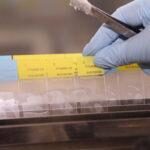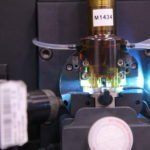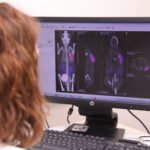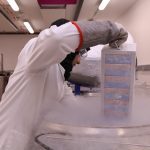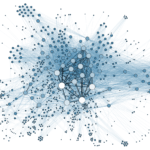
Contact
Dr Linda Hammond
Microscopy Service Manager
+44 20 7882 5132
Microscopy
The Microscopy Service provides access to cutting-edge imaging instrumentation to researchers at the CRUK Barts Centre and houses a diverse range of microscopy instruments from advanced confocal imaging systems, laser microdissection to time lapse microscopes suiting a wide range of applications. This service has a dedicated manager who can provide advice on experimental design, sample preparation and data analysis. The service is available for external users. All new users will be trained to use the instruments and bookings will have to be made using the online booking system – iLab Solutions. Location: 3rd Floor, John Vane Science Centre, Charterhouse Square, London
Confocal microscopes
Nikon Spinning Disk Confocal Microscope, Zeiss LSM 710 Confocal Microscope, Zeiss LSM 880 with Airyscan Fast
Time lapse systems
IncuCyte ZOOM, IncuCyte S3, DeltaVision, AxioVert Time Lapse Microscope
Digital pathology
NanoZoomer S60 Slide Scanner, NanoZoomer S210 Slide Scanner, Pannoramic 250 Slide Scanner, Ariol
Other
PALM Laser Capture, SteREO Lumar V12 microscope, Axioplan, Axiophot
Internal users: please visit the Intranet
QMUL users: please contact Dr Linda Hammond
External users:
|
Model |
Price per hour |
|
NanoZoomer S210 bright-field scanner |
£20 |
|
NanoZoomer S60 fluorescence/ bright-field scanner |
£20 |
|
Panoramic 250 bright-field scanner |
£20 |
|
Ariol |
£15 |
|
PALM Laser Capture System |
£20 |
|
LSM 880 with Airyscan Fast Confocal Microscope |
£40 |
|
LSM 710 Meta Inverted Confocal Microscope |
£30 |
|
Spinning Disk Confocal |
£30 |
|
DeltaVision |
£8 |
|
Axioplan |
£8 |
|
Axiophot |
£8 |
|
IncuCyte ZOOM and IncuCyte S3 |
£2 (please contact Manager) |
|
Time Lapse |
£2 (please contact Manager) |
Confocal microscopes
The Facility has a spinning disk system and two point-scanning confocal microscopes.
- Nikon Spinning Disk Confocal Microscope
The Nikon spinning disk confocal microscope is suitable for imaging of dynamic processes in living cells and fast acquisition of Z stacks in live and fixed preparations. The spinning disk ensures the sample is illuminated and light detected at multiple points simultaneously. Photobleaching and phototoxicity are reduced when imaging with this system.
The Nikon Spinning Disk confocal microscope is equipped with a solid state LUN-V laser unit 405/445/488/514/561/640nm. Two sCMOS cameras allow imaging of both confocal and widefield applications: an Andor Zyla sCMOS camera for spinning disk option and a Hamamatsu ORCA-Flash 4.0v2 sCMOS camera for wide-field imaging.
The Ti-E fully motorised inverted microscope has a pE-4000 LED fluorescence light source and CoolLED pE-100 diascopic white light source. Objectives are Plan Apo 10x; Plan Apo VC 20x; Super Plan Fluor ELWD 20x; Plan Flur 40x/1.3 Oil; Plan Apo Lambda 60x/1.40; Plan Apo Lambda 100x/1.45.
The microscope has an Okolab environmental chamber for live imaging while the Nano-Z200 piezo Z drive and Perfect Focus system maintain focus throughout time lapse acquisitions.
Images are acquired and analysed using NIS Elements Advanced Research software.
- Zeiss LSM 710 Confocal Microscope
The LSM 710 point-scanning confocal microscope is equipped with four lasers and a 34 channel spectral system. Lasers are Diode 405nm, Multi-line Argon 458/ 488/ 514 nm, HeNe 543nm and HeNe 633nm.
The microscope has an Axio Observer.Z1 motorised stand with 3 position optovar turret for DAPI, GFP and Cy3. Available objectives are Plan-Apochromat 63x/1.40 Oil DIC; Plan-Apochromat 40x/1.30 Oil DIC; EC Plan-Neofluar 20x/0.50; EC Plan-Neofluar 10x/0.30 and LD 20x/
The microscope is inverted and fitted with an environmental chamber, allowing users to perform live imaging experiments that can be recorded as a time series. The scanning stage has inserts to accommodate slides, dishes and plates.
We have modules for Z-stacking, Tiling, Time Series, Bleaching and Positions. Applications utilise the optical sectioning ability of the microscope and include studies on localisation, co-localisation, endocytosis and invasion in both fixed and live samples.
Images are acquired and analysed using Zen 2009 software.
- Zeiss LSM 880 with Airyscan Fast
The LSM 880 point-scanning confocal microscope has an Axio Observer Z1 motorised stand with 3 position optovar turret for DAPI, GFP and Cy3. Available objectives are Plan-Apochromat 63x/1.40 Oil DIC; Plan-Apochromat 40x/1.30 Oil DIC; PA po 20x/0.80; PA po 10x/0.45 and LD 40x/1.30 Corr.
The microscope is inverted and fitted with an environmental control chamber, allowing users to perform live imaging experiments that can be recorded as a time series. The scanning stage has inserts to accommodate slides, dishes and plates. The microscope is equipped with a Fast Z piezo insert for fast acquisition of Z stacks and Definite Focus 2 for keeping focus during time series.
The LSM 880 has four lasers: these are Diode 405nm, multi-line Argon 457/ 488/ 514 nm, HeNe 561nm and HeNe 633nm. The 34 channel spectral system comprises two PMT and 32 x channel GaAsP detectors. A transmitted light detector allows differential interference contrast (DIC) imaging. The system is equipped with an Airyscan super resolution detector and Fast module.
Images are acquired and analysed using Zen software with modules for Z-stacking, Tiling, Time Series, Bleaching, Positions, Regions and FRAP. Applications utilise the fast optical sectioning ability of the microscope and include studies on localisation, co-localisation, endocytosis, invasion and the tumour microenvironment in both fixed and live samples. We have an offline software licence for analysis
Time Lapse Systems
- IncuCyte ZOOM
The IncuCyte ZOOM imaging system allows simultaneous imaging of up to six culture vessels within a tissue incubator. It is ideal for fluorescence and phase contrast imaging of time lapse experiments.
The IncuCyte consists of a microscope gantry, that resides inside a cell incubator, The system houses tissue culture flasks or microtiter plates and can acquire >2000 images per hour. There is a choice of 4x, 10x or 20x objectives. High definition phase contrast images are generated and a dual colour filter cube allows imaging of green and red fluorescence. The WoundMaker is available to generate wounds for scratch assays.
Image data is collected and processed by a networked external hard drive that generates time based growth curves. Applications include proliferation, cytotoxicity, apoptosis and scratch wound assays.
Experiments are set up, acquired and analysed using IncuCyte ZOOM software.
- IncuCyte S3
The IncuCyte S3 live-cell analysis system is a more recent version of the IncuCyte ZOOM and has the same functionality but with certain features that allow greater flexibility during acquisition.
Special software modules available with the IncuCyte S3 are the Tumour Spheroid module for analysing tumour spheroid formation, growth or shrinkage and Cell-By-Cell Analysis for studying cell subsets and heterogeneity.
Experiments are set up, acquired and analysed using IncuCyte S3 software.
- DeltaVision
The DeltaVision system has an inverted research microscope with environmental chamber and fast, high resolution camera. It is suitable for imaging cells on slides or in culture dishes by fluorescence, bright field, phase contrast and DIC. This microscope allows multi-position time lapse imagining of Z stacks with high accuracy. The main application is imaging cell division in detail.
The Olympus IX71 inverted stand is fitted with an IMSOL incubator environment control system and an API white LED transmitted light illuminator. A Trulight Fluorescence Illuminator facilitates DAPI/FITC/TRITC/Cy5/CFP/YFP and GFP/mcherry imaging. Images are captured with a CoolSNAP HQ2 camera. Available objectives are 20x/0.85 Oil DIC; 40x1.30 Oil DIC; 60x/1.42 Oil DIC and 100x/1.40 Oil DIC.
Images are acquired and analysed using SoftWoRx image analysis software.
- AxioVert Time Lapse Microscope
The Zeiss Axiovert 200M inverted, epi-fluorescence microscope allows fluorescence and phase contrast imaging of live cells.
The microscope is motorised and equipped with a scanning stage and environment chamber. Available phase objectives allow imaging at 5X, 10x, 20x, and 40x. An HBO lamp provides light for fluorescence excitation and filter sets are for FITC, Cy3 and Far Red. Images are captured by an AxioCam MRc monochrome camera.
The main application for this microscope is the sequential imaging of multiple, pre-defined locations in a culture plate over a period of time using the Mark & Find module of Zeiss AxioVision software.
Digital Pathology
- NanoZoomer S60 Slide Scanner
The NanoZoomer S60 slide scanner from Hamamatsu has the capacity for 60 slides and can image in fluorescence or bright field. The main application is the scanning of fluorescently labelled sections or cells, including those stained by Fluorescence In Situ Hybridisation. This scanner is also able to image Mega slides.
The S60 has capability to scan at 20x or 40x in manual, semi-automatic or fully automatic mode. Fluorescence filters are for DAPI, SpectrumAqua, FITC, TRITC, Texas Red and Cy5. The Orca Flash4 sCMOS monochrome camera offers high sensitivity and performance in fluorescence while a high quality colour CMOS camera is used to obtain bright field images.
The NDP.view2 software for viewing images is free to download on a PC or MAC.
- NanoZoomer S210 Slide Scanner
The NanoZoomer S210 slide scanner from Hamamatsu has the capacity for 210 bright field slides and is used for imaging tissue sections and tissue microarrays (TMAs) stained by histochemistry or immunohistochemistry.
The S210 has the capability to scan at 20x or 40x in manual, semi-automatic or fully automatic mode. Images are obtained using a high quality colour CMOS camera.
The NDP.view2 software for viewing images is free to download on a PC or MAC.
- Pannoramic 250 Slide Scanner
The Pannoramic 250 is a high throughput, bright field scanner with a 250 slide capacity. It allows bright field scanning of whole tissue sections or TMAs and subsequent analysis using Densito Quant, Nuclear Quant and Membrane Quant modules
Slides can be scanned in manual or automatic mode. Imaging is by a 20x objective and images can be viewed up to 43x magnificaton. The preview camera also records the slide label and the scanner can read bar codes.
Slides are scanned, viewed and analysed using dedicated Pannoramic Scanner, Viewer and Analysis software.
- Ariol
The Ariol system is used for the scanning and quantification of immunohistochemical staining and immunofluorescence. The main application is the collection and analysis of data from tissue sections and tissue microarrays including those stained by Fluorescence In Situ Hybridisation. Nuclear, cytoplasmic and membranous markers can be quantified in terms of intensity, size and number of positive events.
The Olympus BX61 microscope has a Prior stage to accommodate up to eight slides that can be identified by bar code. For fluorescence imaging, the system has an X-Cite 120 Q light source and filter sets for DAPI, Spectrum Aqua, Spectrum Green, Spectrum Orange and Far Red. The microscope is equipped with 1.25x and 5x objectives for locating samples and 10x, 20x, 40x and 60x objectives for image acquisition. An Olympus iAi camera captures the images.
Acquisition and analysis are carried out using dedicated Ariol software.
PALM Laser Capture
The P.A.L.M. Microbeam system is for the microdissection and capture of specified regions from tissue samples for subsequent extraction of DNA, RNA or protein. The system works by a process of laser dissection, followed by pressure catapulting. Samples can be collected from paraffin-embedded sections, frozen sections or cultured cells.
The PALM has a Zeiss Observer Z1 fully motorised inverted microscope with a stage insert to hold three slides. The RoboMover collection device accommodates up to eight eppendorf tubes.
The system has an HAL 100 illuminator for bright-field work and an HXP 120 C illuminator for fluorescence. Filter sets are for DAPI, FITC and Texas Red. The PALM is equipped with digital microscopy camera AxioCam ICc 1. Available objectives are Fluar 5x/0.25;Fluar 10x/0.5; LD Plan-Neofluar 20x/0.4 Corr; LD Plan-Neofluar 40x/0.6 Corr; LD Plan-Neofluar 63x/0.75 Corr .
The PALM laser capture system is controlled by PALM Robo v4.6 software.
SteREO Lumar V12 microscope
This stereo microscope is used for 3D observation and imaging of small objects. Both bright-field and fluorescence options are available. The main application is observation and imaging of Drosophila or tissue pieces expressing fluorescent markers.
The SteREO Lumar V12 microscope has a SyCop system control panel and a choice of S 1.5x and S 0.8x objectives. It is equipped with a halogen light source for brightfield, darkfield or DIC work and an HBO 100 fluorescence light source with a filter set for DAPI, FITC and TRITC. The microscope has a Zeiss HRm monochrome camera.
Imaging is carried out using Zeiss AxioVision v 4.8 software.
Axioplan
The Zeiss Axioplan is an upright, epi-fluorescence microscope for bright field and fluorescence imaging of tissue sections and cells.
The Axioplan is a manually controlled microscope with a halogen and an X-Cite light source. Filter sets allow imaging of DAPI, FITC and TRITC. Available objectives are Plan-Neofluar 2.5x/ 0.075; Fluar 5x/ 0.25, Plan-Apo 10x/0.3, Plan-Neofluar 20x/0.5; Plan-Apo 40x/ and Plan-Apochromat 63x/1.40 Oil. This microscope is equipped with an AxioCam MRc monochrome camera.
Images are acquired using AxioVision software.
Axiophot
The Zeiss Axiophot 1 is an upright, epi-fluorescence microscope for bright field and fluorescence imaging of tissue sections and cells. The main application is the bright field imaging of tissue sections stained by histochemistry and immunohistochemistry.
The Axiophot is a manually controlled microscope with a halogen and an HBO light source. Filter sets are for DAPI, FITC and TRITC. Available objectives are Plan-Neofluar 2.5x/0.075; Plan-Apo 5x/ 0.25, Plan-Neofluar 10x/0.3, Plan-Apo 20x/0.5; Plan-Neofluar 40x/0.75 and Plan-Neofluar 63x/1.25 Oil. This microscope is equipped with an AxioCam HRc colour camera.
Images are acquired using AxioVision software.
Analysis Software
Analysis workstations are available for offline processing of acquired images.
- Imaris
Imaris version 9.1 for 3-D and 4-D image processing and analysis
Imaris Neuroscience version 9.1, MeasurementPro and FilamentTracer. Imaris-XT version 9.1. Imaris TrackLineage version 9.1.
- MetaMorph
MetaMorph Offline Premier with modules for Count Nuclei and Cell Scoring, Multi wavelength Cell Scoring, Cell Cycle, granularity and Angiogenesis.
- Visiopharm
Recently acquired, this powerful and configurable software is for quantitative analysis of digital pathology images.
A variety of software modules allow automated image analysis for different tasks.

